Milton Friedman once said, “Nothing is so permanent as a temporary government programme.” This idea is very relevant when starting an ecommerce platform in Italy. The country is full of opportunities for innovation.
Italy is the 14th biggest ecommerce market worldwide. It’s a great place for entrepreneurs to start their online stores. The market is growing fast, with a value of 75.89 billion euros in 2022.
Starting an ecommerce platform in Italy is easy because you don’t need to be a citizen. The country is also well-connected to Europe, Africa, and the Middle East. This makes it a great spot for new businesses.
We will look into the Italian ecommerce market more. We’ll see the chances it offers and what steps we need to take to succeed.
Why Start an Ecommerce Platform in Italy?
Starting an ecommerce platform in Italy is attractive for many reasons. About 50 million Italians use the internet, creating a strong base for online businesses. With nearly 40 million people shopping online, the customer base is growing.
Italians spent around €76 billion online in 2022. This shows the big market waiting for entrepreneurs.
Italy’s location is great for trading, reaching both EU and non-EU customers. This is a key reason to start an ecommerce business here. Also, with 40% of sales on mobile devices, businesses can easily connect with customers.

Starting a business in Italy is easy, needing no citizenship or residency. This makes it simple for entrepreneurs from all over to join the market. Italy’s high social media use, with 44 million active users, offers new ways to reach customers.
As ecommerce grows globally, Italy is a prime spot for businesses. It’s expected to reach $6.9 trillion by 2025. The demand and EU support make Italy a great place to start an ecommerce business.
The Advantages of Ecommerce in Italy
Setting up an ecommerce site in Italy has many benefits for our business. Italy’s central location makes it easy to reach major European markets. This helps us sell to more people across the continent.
Italian customers love online shopping. In fact, 94% of Temu users in Italy prefer buying online over visiting stores. This shows they trust online shopping, with 89% confident in what they buy online. With 86% saying online products are good quality, we can meet their high standards.
Also, 92% of consumers think buying directly from manufacturers saves money without losing quality. This makes our products more appealing and builds customer loyalty. Since 9 out of 10 Italians look at price when buying, we can offer great deals to attract them.
Running an ecommerce site can also save us money. The Italian ecommerce market is growing fast, with a 8.60% growth rate from 2024 to 2032. It’s expected to grow from US$ 85.88 Billion to US$ 192.77 Billion by 2032. This growth is due to more people using the internet and smartphones. By joining this market, we can make a lot of money and stay profitable.
In summary, using an ecommerce platform brings many benefits. We save money, have better logistics, and reach a quality-focused customer base. Being part of Italy’s booming digital market is a huge opportunity for us.

Understanding the Italian Ecommerce Market
The Italian ecommerce market is booming, thanks to tech-savvy consumers and new technologies. In 2022, over a third of the population bought something online. This led to nearly 76 billion euros in sales.
This shows a strong online shopping culture in Italy. Experts predict even more growth in the future.
Most Italians, 86.9% as of 2023, are connected to the internet. Knowing what they like online is key. For example, 47% prefer home delivery that needs a signature.
With almost 50 million smartphone users expected by 2024, mobile shopping is on the rise. This is a big trend in Italy’s ecommerce scene.
Clothing and footwear are the top choices for online shoppers, making up 41% of sales. Brands like Shein and MediaWorld cater to tech lovers and fashion enthusiasts alike. As the market evolves, focusing on social commerce and mobile shopping will be crucial for success.

Eligibility to Start an Ecommerce Platform in Italy
Starting an ecommerce business in Italy is open to all entrepreneurs. Knowing the requirements is key to success. We’ll look at who can start an ecommerce business in Italy, for both EU and non-EU residents.
Requirements for EU Residents
EU residents have an easier time registering their businesses. They need to:
- Get a tax identification number.
- Register with the Chamber of Commerce.
- Follow local financial rules.
This makes it simpler for Europeans to start in Italy. They can use their EU registration for ecommerce.
Requirements for Non-EU Residents
Non-EU residents face more challenges in Italy. They often need a long-term visa, which is complex. Or, they can partner with an Italian citizen who owns at least 50% of the business.
For new business ideas, the Startup Visa is an option. It requires a minimum investment. Knowing these options is crucial for non-EU entrepreneurs.

Choosing the Right Business Structure
Setting up an ecommerce platform means picking the right business structure is key. In Italy, you can choose between an LLC and being a sole trader. Knowing these options helps us decide based on our needs and goals.
Limited Liability Company (LLC)
An LLC is a mix of flexibility and protection that many find attractive. It offers limited liability, keeping personal assets safe from business debts. But, setting up an LLC is more complex and requires ongoing compliance.
This structure is good for growing your business and attracting investors. It’s because it’s formal and structured.
Sole Trader Registration
Registering as a sole trader in Italy is simpler and less costly. It gives you full control over your business. But, it offers little protection against personal liability.
As a sole trader, your personal assets could be at risk if the business owes money. The choice between an LLC and being a sole trader depends on your goals, risk level, and financial plans.
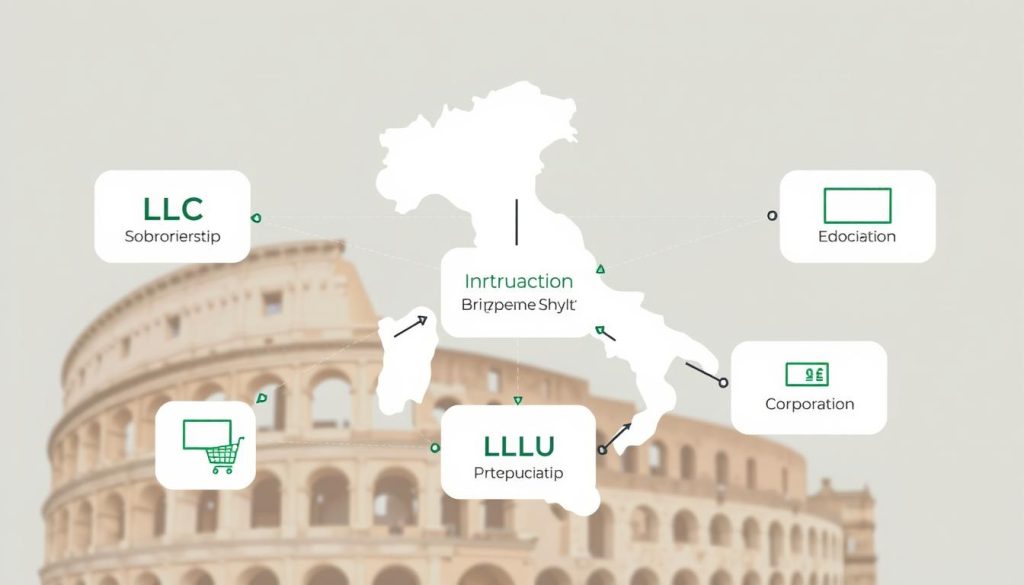
Steps to Open an Ecommerce Business in Italy
Starting an ecommerce business in Italy needs a clear plan. We must follow the ecommerce business registration steps carefully. First, we need to register with the Tax Authorities. This is key to keeping track of our business and its duties.
Registering with Tax Authorities
Getting a codice fiscale is our first task. This is a must for anyone doing business in Italy. We need to apply with the right documents, like ID and proof of where we live.
Obtaining a VAT Number
After registering with the Tax Authorities, we get a VAT number. Italy’s VAT rate is 22%. This number helps us keep track of sales tax and meet our tax duties. It’s vital for selling in the Italian market.

Setting Up a Business Bank Account
Getting a business bank account in Italy is key for managing your ecommerce finances well. It keeps your personal money separate from your business money. This makes your financial records clear and accurate.
It also makes bookkeeping easier and gives a professional look to your customers and suppliers.
To open a business bank account in Italy, you need to provide some important documents. These usually include:
- Certificate of incorporation
- Proof of address
- Personal identification for each signer
When picking a bank, look at their reputation and what customers say. For example, Tide Business Bank Accounts has a 4-star Trustpilot rating. It’s a good choice for small businesses.
Equals Money has a 4.6-star Trustpilot score, offering great features. If you prefer digital banking, Revolut Business Accounts has a 4.2-star Trustpilot rating. It shows positive feedback from users.
Choosing the right business bank account is crucial for your ecommerce success in Italy. The right bank supports your financial management and boosts your business strategy.

Acquiring Your Product Line
Setting up our ecommerce platform in Italy means finding the right products. We can source locally or import from abroad. Each method has its pros and cons. Knowing these helps us manage our inventory better.
Sourcing Locally vs Importing
Local sourcing makes logistics easier and cuts shipping costs. It also helps us build strong supplier relationships. This leads to better quality and faster responses to market needs.
Importing, however, opens up a wider range of products. This can make our offerings stand out in a crowded market. But, we must follow EU rules and handle customs well to avoid extra costs.
Dropshipping is a popular choice today. It lets us start without big inventory costs. With Italy’s ecommerce growing to $5.7 billion last year, the right strategy can give us an edge.
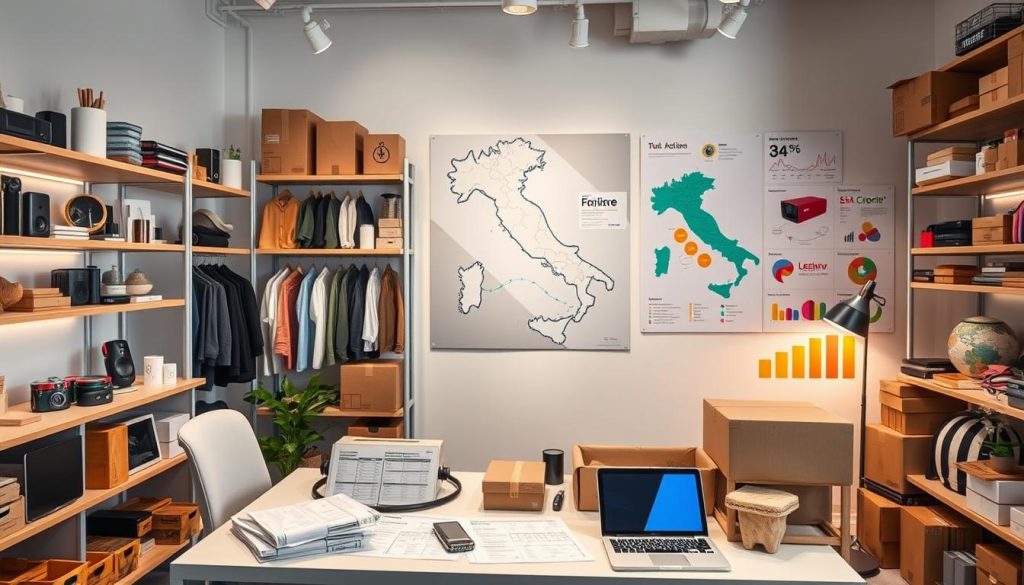
Creating Your Ecommerce Platform
A strong online presence starts with a good ecommerce website. The first step is to pick the right domain. A good domain boosts our brand and credibility. For Italy, a .it domain is key to reaching local customers.
Choosing the Right Domain
Our domain should match our brand and be easy to remember. Domains can cost as little as $1 a year. This small cost can greatly improve our platform’s trust and recognition.
Designing Your Website
Website design is crucial for a good user experience. This keeps customers coming back. We should make our site mobile-friendly, as more people shop on phones.
Fast loading times are important to keep visitors interested. SEO helps us show up in search results. Using quality images and consistent branding makes our site look modern and easy to read.
Tools like Shopify help us start fast, fitting all budgets. Using online marketing tools like Google Ads can also help attract customers early on.

Compliance with Italian Ecommerce Regulations
Ensuring we follow ecommerce laws is crucial for success in Italy. We must know the rules that protect consumers and keep our businesses safe from fines.
Consumer Protection Laws
Consumer protection laws are essential for ecommerce. They tell us what we must do about refunds, warranties, and other consumer rights. Following these laws builds trust with our customers and protects their interests.
About 30% of Italian ecommerce sites fully follow these laws. This means a lot of sites could be putting consumers at risk. We need to have strict policies that respect consumer rights in Italy.
Data Protection and GDPR Compliance
The General Data Protection Regulation (GDPR) is a big deal for data protection in Europe. For ecommerce, it means we must handle personal data the right way. Sadly, 70% of Italian ecommerce sites don’t handle user data well.
Not following data laws can lead to huge fines. For example, a big internet marketplace was fined €746 million for not getting user consent right. We must focus on good privacy policies to keep our customers safe. Following the law not only avoids fines but also makes our site more trustworthy and appealing.

Financial and Tax Obligations in Italy
Starting an ecommerce business in Italy means we must understand our financial and tax duties. The standard VAT rate is 22%. But, some items and services get lower rates. For example, food items have a 4% rate, while health services and utility supplies have 5% and 10% rates, respectively.

It’s crucial to follow the rules. We must report our sales and purchases accurately. This is especially true for exports, which might be VAT-free under certain rules. We also need to submit an electronic declaration of intent for exports.
Input VAT on our business purchases can usually be claimed back. But, there are some exceptions. Keeping good records is key. We must file our VAT return by April 30 of the next year. Since 2019, we’ve had to use electronic invoicing for all transactions between residents.
- We must send cross-border sales and purchases data to the authorities in XML format.
- Any mistakes in our reports can cost us up to EUR 400 a month.
- Since July 1, 2022, we’ve had to use electronic invoicing for sales to San Marino.
In short, managing our ecommerce finances well helps us follow Italy’s tax laws. Getting advice from a tax expert who knows these rules can be very helpful.
Marketing Strategies for Your Ecommerce Platform
To succeed in the competitive ecommerce world in Italy, we need effective marketing strategies. With over $1.65 trillion spent on ads and marketing in 2023, our approach must be unique. Knowing our market and using different channels will help us attract more customers in Italy.
Our strategies should include various methods to increase reach and engagement:
- Search Engine Optimisation (SEO): Making our website rank higher will bring more organic traffic. A top-ranked page is much more likely to get clicked than lower ones.
- Social Media Marketing: Sites like TikTok are great, with 69% of brands using influencer marketing. This can boost our brand’s visibility and draw in more people.
- Email Campaigns: Personalised emails can build relationships and increase sales. They help keep our current customers coming back.
We should set clear goals using the SMART framework for our KPIs. Key metrics include conversion rates, customer acquisition costs, and average order values. Also, having a budget based on our business size helps us spend wisely.
Market research is key in shaping our marketing plans. It includes looking at competitors, surveying customers, and doing SWOT analysis. A/B testing helps us improve by trying out different things like prices and product images.
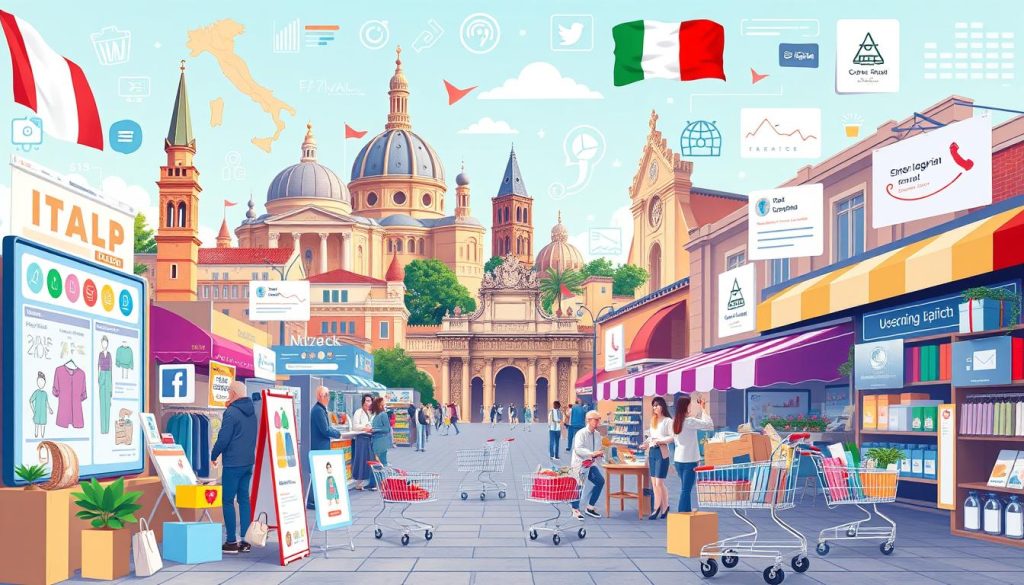
To make the most of our marketing budget, we should look for effective patterns. Online retailers often spend less on marketing because they have strong brand awareness. Google says PPC ads can bring in $11 for every $1 spent. Using these insights in our strategy will help us grow and succeed.
Building Trust and Security for Customers
Building trust with our online customers is key to our success. Privacy and security worries greatly affect how people shop online. In 2020, Statista found that over 38% of scams worldwide were linked to online shopping.
To tackle these worries, we need strong cybersecurity for our online stores. Using secure payment gateways with SSL certificates is crucial. Trust seals and money-back guarantees also boost customer confidence. A user-friendly website with clear product info and prices is essential too.
Providing top-notch customer service is also vital. Quick and helpful support builds strong customer relationships. When customers feel supported, they are more likely to stay loyal. In fact, 94% of consumers prefer brands that are fully transparent.
We should also showcase customer reviews and testimonials. Seeing positive feedback from others encourages more people to buy. Being open and honest about our products and practices is important.
The future of online shopping will focus on privacy, augmented reality, and better fraud prevention. Keeping up with these trends will help us keep our customers’ trust in a fast-changing world.
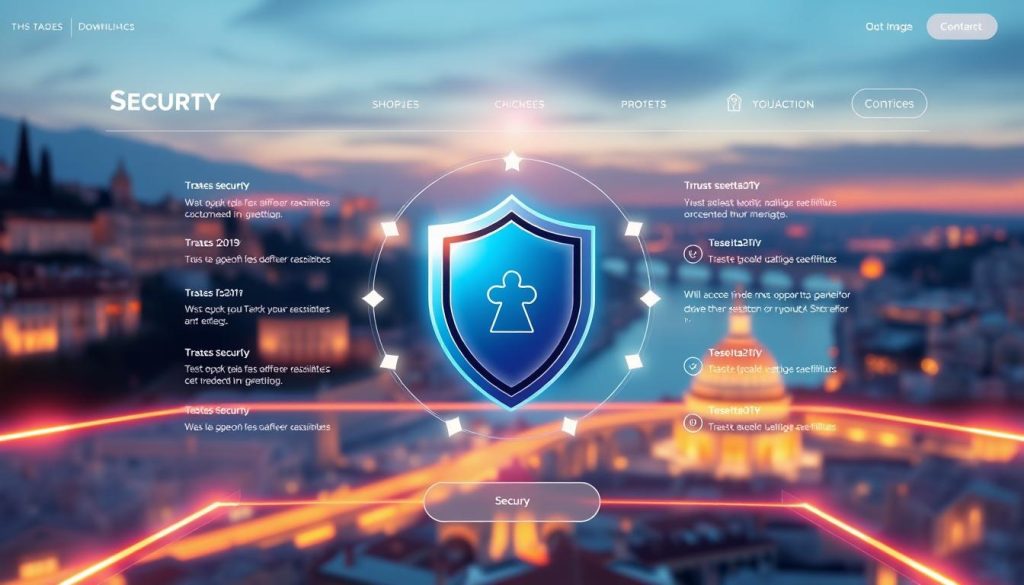
Evaluating the Competition in the Italian Market
Understanding the competition is key for new businesses in Italy. The digital market here is worth USD 7.69 billion in 2023. It’s expected to hit USD 13.29 billion by 2030. Knowing the market well can help us succeed.
About 93% of Italians use the internet. This means a big customer base for us. Knowing what Amazon, eBay, and Alibaba do well helps us plan better. We can focus on quality, which 60% of online shoppers prefer.
Market research shows that fashion, home goods, and gourmet food are big in Italy. These areas value high-quality products. Using events like ‘Festa della Repubblica’ and ‘Natale’ can boost sales by up to 40%.
AR and VR are set to change the Italian digital market. Keeping up with these trends helps us meet customer needs better.
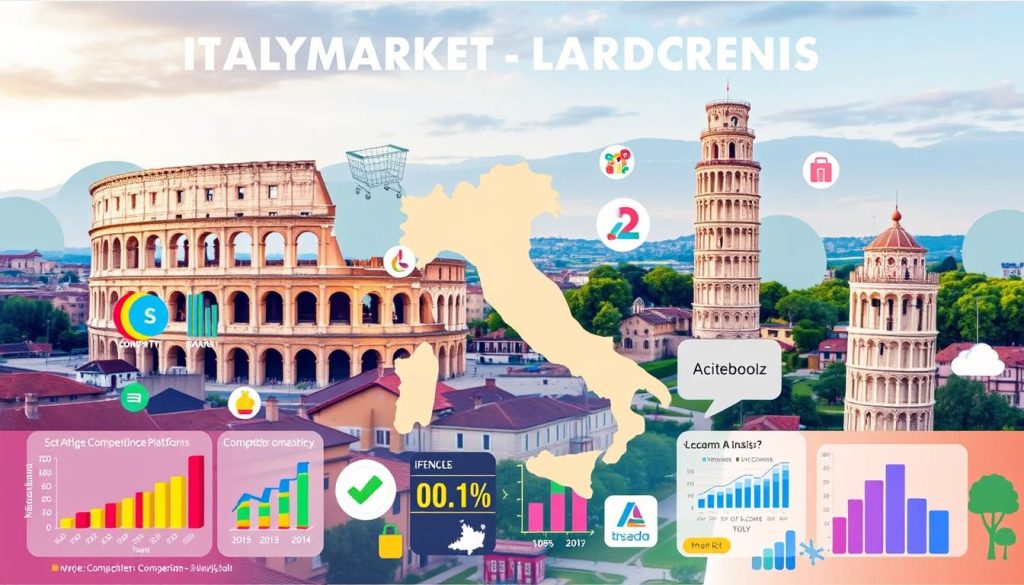
Looking at customer feedback and trends helps us stand out. We can create marketing that speaks to Italian shoppers. A deep dive into the competition boosts our chances of success in this fast-growing market.
Future Trends in Italian Ecommerce
The future of ecommerce in Italy is looking bright. Transactions have already hit €48 billion, and we’re expecting €76 billion in 2022. This shows our digital market is growing fast.
More people are shopping on their mobiles, with 40% of sales coming from mobile devices and cards. Also, 68.2% of Italians are now shopping online. This shows they’re really getting into it.
Personalised marketing and AI are becoming key to better shopping experiences. Almost half of online shoppers in Italy think AI can make their shopping better. And 65% are ready to try AI in their shopping.
This is a big chance for businesses to use new tools that meet their customers’ needs.
Social media is also playing a big part in what people buy. With 75% of the population on social media, social commerce in Italy is huge. By 2027, ecommerce is expected to hit almost €74 billion. Keeping up with trends will be key to success.









